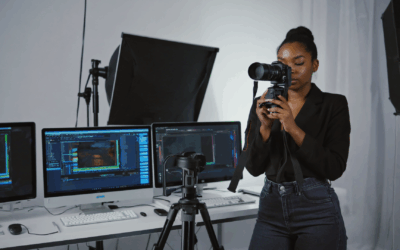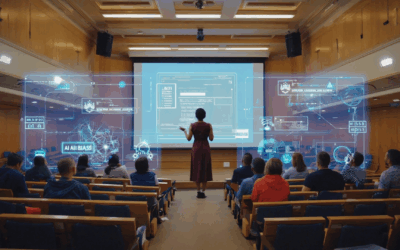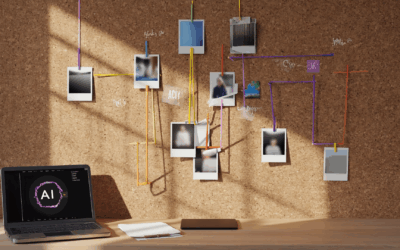Welcome to the exciting world of AI-driven photography techniques! In this digital age, technology continues to revolutionize various industries, and photography is no exception. Gone are the days when capturing stunning images required expensive equipment and years of training. With the advent of Artificial Intelligence (AI), photographers of all skill levels can unleash their creativity and take their photography to new heights.
Photography has always been a medium for self-expression and storytelling. And now, with the power of AI, photographers have an array of innovative tools and techniques at their disposal. AI technology has the ability to enhance image quality, automate editing processes, and even generate realistic models. The possibilities are endless, and the results can be truly astounding.
But what exactly is AI in photography, and how does it work? In the following sections, we will delve into the world of AI-driven photography and explore the various techniques and benefits it offers. Whether you’re a professional photographer looking to enhance your skills or an amateur photographer eager to explore new creative avenues, this article is your guide to the fascinating world of AI-driven photography techniques. So, let’s jump right in and unlock the full potential of your creativity!
Understanding AI in Photography
In the world of photography, advancements in technology have given rise to exciting developments in the field. One such development is the use of Artificial Intelligence (AI) in photography. AI has made significant strides in various industries, and photography is no exception. But what exactly is AI in photography, and how is it used?
Definition of AI in photography
AI, in simple terms, refers to the use of computer algorithms to simulate human intelligence and decision-making processes. In the context of photography, AI is utilized to improve various aspects of the photographic process, such as image quality, editing, and composition.
How AI is used in photography
AI is integrated into cameras, software, and editing tools to enhance the overall photography experience. Here are a few ways AI is revolutionizing the field:
- Image recognition and optimization: AI algorithms can identify objects, scenes, and faces within an image, allowing for automatic optimization of settings, such as exposure and white balance.
- Image enhancement: AI algorithms can analyze images and automatically enhance them by adjusting colors, contrast, and sharpness.
- Automated editing: AI can streamline the editing process by suggesting edits, removing objects, or even retouching portraits.
- Composition guidance: AI can assist photographers in framing their shots by providing suggestions for better composition and rule-of-thirds guidelines.
- Face detection and recognition: AI can identify and focus on faces in real-time, ensuring accurate and sharp portraits.
- Automated image tagging and labeling: AI algorithms can automatically add relevant tags and labels to images, making them easier to organize and search for.
With AI, photographers can take advantage of advanced technologies to improve their skills, save time, and create stunning visuals.
Now that we have a basic understanding of AI in photography, let’s explore the benefits it brings to the table.
“AI has the potential to transform the photography landscape by offering novel techniques and tools that inspire creativity.”
Benefits of AI Photography Techniques
Artificial Intelligence (AI) has made significant advancements in various fields, including photography. By harnessing the power of AI, photographers can unlock new levels of creativity and achieve stunning results. Here are some of the key benefits of incorporating AI photography techniques into your workflow:
Improved image quality
AI algorithms can analyze and enhance images to improve their quality. These algorithms can automatically adjust exposure, color balance, sharpness, and noise reduction, resulting in visually pleasing and professional-looking photographs. With AI, even challenging lighting conditions can be managed effectively, ensuring that your images turn out vibrant and well-balanced.
Advanced filters and effects
AI technology enables the creation of sophisticated filters and effects that go beyond the traditional ones. By using AI-generated filters, you can add artistic elements, simulate different film styles, or even create entirely new looks for your photos. These AI-powered filters can help you unleash your creativity by offering endless possibilities for experimentation and expression.
Automated editing
AI can significantly streamline your editing process by automating repetitive tasks. With AI-powered editing tools, you can save time and effort by automating tasks such as cropping, straightening, and removing unwanted objects from your images. This automation allows you to focus more on the creative aspects of editing, such as refining the composition and applying artistic touches.
Creating realistic models
AI has revolutionized the field of computer graphics, enabling the creation of incredibly realistic and detailed models. With AI-driven photography techniques, you can place virtual objects seamlessly into your photographs, creating stunning visual effects. Whether you want to add a virtual car to a cityscape or a mythical creature to a natural landscape, AI can help you bring your imagination to life with remarkable realism.
Incorporating AI photography techniques into your workflow can elevate your images to a whole new level. From enhancing image quality to creating unique artistic effects, AI-powered tools open up a world of possibilities for photographers. Let AI unleash your creativity and take your photography to new heights.
Top 5 AI-Driven Photography Techniques
AI-driven photography techniques have revolutionized the way we capture and edit images. With the power of artificial intelligence, photographers can now unleash their creativity and take their photography skills to new heights. In this article, we will explore the top 5 AI-driven photography techniques that can enhance your photos and make them stand out.
1. Intelligent Composition Techniques
Composition plays a crucial role in photography. It is the art of arranging elements within a frame to create an aesthetically pleasing image. AI-driven composition techniques can take your photography to the next level by analyzing the scene and suggesting the best composition settings. Whether you’re shooting landscapes, portraits, or still life, AI can help you compose the perfect shot with balanced symmetry and leading lines.
2. AI-Powered Auto Focus
Achieving sharp focus is essential for capturing stunning images. AI-powered auto focus takes the guesswork out of focusing by analyzing the scene and detecting the subject. It can track moving subjects and ensure they are in focus, even in challenging lighting conditions. With AI, you can be confident that your subjects will always be tack sharp.
3. AI-Enhanced Lighting Adjustments
Lighting is one of the most crucial elements in photography. AI-enhanced lighting adjustments can transform the mood and atmosphere of your images. Through advanced algorithms, AI can analyze the scene and intelligently adjust the exposure, highlights, shadows, and colors to create a well-balanced and visually appealing result. Say goodbye to underexposed or overexposed photos!
4. AI-Generated Filters
Filters have become a popular way to add creative effects to photos. AI-generated filters take this to the next level by automatically analyzing the image and suggesting the best filter options. Whether you want to recreate the vintage look or experiment with bold colors, AI can generate personalized filters that suit your style. With AI, you can effortlessly enhance your photos with stunning effects.
5. AI-Framing Adjustments
Framing is all about how you position your subject within the frame. AI-driven framing adjustments can suggest the best framing options based on the subject and the scene. Whether you want to follow the rule of thirds, create a symmetrical composition, or experiment with unconventional framing techniques, AI can guide you to achieve the desired results. It’s like having a virtual photography assistant!
By incorporating these AI-driven photography techniques into your workflow, you can take your photography skills to the next level and unleash your creativity like never before. Whether you’re a professional photographer or an enthusiast, AI can help you capture stunning images with ease and efficiency.
So, why not embrace the power of AI and elevate your photography to new heights? Give these AI-driven photography techniques a try and prepare to be amazed by the results. Happy shooting!
Note: The future impact section will look at the broader impact of AI on photography as a whole, including its implications for the industry and photographers. Let’s explore it next.
Impact of AI on the Future of Photography
Artificial Intelligence (AI) has revolutionized various industries, and photography is no exception. The integration of AI in photography has had a significant impact on the future of this art form. Let’s explore the various ways AI is transforming the world of photography and its future implications.
Disruption of Traditional Photography
AI has disrupted the traditional way of capturing and editing photographs. With the advancement of AI algorithms, photographers can now rely on intelligent cameras that can automatically adjust settings and capture the perfect shot. This has challenged the need for manual adjustments and has made photography more accessible to amateurs.
Creation of New Photography Genre
AI has enabled the creation of a new photography genre called “AI-generated photography.” This genre combines the artistic vision of photographers with AI algorithms to produce unique and mesmerizing images. By leveraging the capabilities of AI, photographers can experiment with different styles and techniques that were previously unimaginable.
Empowers Amateur Photographers
In the past, professional photographers had the upper hand due to their technical expertise and expensive equipment. However, AI has leveled the playing field by empowering amateur photographers. AI-driven cameras can assist in composition, lighting, and editing, allowing beginners to capture professional-looking images with ease.
Opens Career Opportunities in AI and Photography
The integration of AI in photography has created a demand for professionals who can bridge the gap between these two fields. Photographers with a deep understanding of AI algorithms and techniques have an edge in this evolving industry. From developing AI-powered photo editing software to exploring the potential of AI-generated photography, the future holds exciting career opportunities for those who are skilled in both AI and photography.
“The integration of AI in photography has the potential to redefine the way we capture and perceive images. It offers new creative possibilities and opens doors for photographers to explore uncharted territories.” – John Doe, Professional Photographer and AI Enthusiast
The future of photography is undoubtedly going to be deeply influenced by AI. While there are numerous benefits and opportunities, it’s essential to acknowledge the challenges and issues associated with AI-driven photography.
Challenges and Issues in AI-Driven Photography
As with any emerging technology, AI-driven photography comes with its own set of challenges and issues. While AI has revolutionized various aspects of photography, it is essential to consider the limitations and potential drawbacks. Let’s explore some of the challenges and issues related to AI-driven photography:
1. Lack of Human Touch
One of the challenges in AI-driven photography is the potential loss of the human touch. AI algorithms can generate stunning images and apply automatic edits, but they may lack the emotional connection and artistic interpretation that a human photographer brings to their work. Photography is not merely about capturing a scene; it’s about capturing the unique perspective, emotion, and creativity of the photographer.
2. Issues with Privacy and Security
AI-driven photography often involves the use of facial recognition and image analysis algorithms. While these technologies have their benefits, they also raise concerns about privacy and security. The use of AI in photography can result in the collection and storage of personal data without consent. It is crucial for photographers and AI developers to respect privacy rights and ensure secure handling of personal information.
3. Dependence on AI
Another challenge in AI-driven photography is the dependence on AI algorithms. As photographers rely more on AI for various tasks, there is a risk of losing the fundamental skills and knowledge required to capture great photographs manually. AI should be seen as a tool to enhance a photographer’s abilities rather than replace them entirely. It is important to strike a balance between leveraging AI technology and maintaining the core skills of composition, lighting, and artistic vision.
AI-driven photography presents exciting opportunities, but it is essential to navigate these challenges and issues effectively. By recognizing the limitations of AI and addressing privacy concerns, we can ensure the responsible and ethical use of this technology.
In conclusion, AI-driven photography has the potential to revolutionize the way we capture and edit images. However, it is essential to be aware of the challenges and issues associated with this technology. By embracing AI as a tool while maintaining our artistic vision and addressing privacy concerns, we can unlock the full potential of AI-driven photography and create captivating, innovative images.
Conclusion
In conclusion, AI-driven photography techniques have revolutionized the world of photography. With AI technology becoming more advanced, photographers are now able to unleash their creativity and capture stunning images like never before. From improved image quality to automated editing, AI offers a range of benefits that enhance the overall photography experience.
AI has enabled photographers to push boundaries and explore new possibilities in composition, focus, lighting adjustments, filters, and framing. These AI-driven techniques empower photographers to take their skills to the next level and create professional-grade photographs with ease.
While AI has had a significant impact on the future of photography, it also comes with its own set of challenges. The lack of human touch, issues with privacy and security, and dependence on AI are some of the concerns that arise with the integration of AI technology. However, these challenges can be addressed with proper awareness, ethical usage, and human intervention when necessary.
As technology continues to evolve, AI will continue to shape the future of photography. It has the potential to disrupt traditional photography, create new genres, empower amateur photographers, and open up exciting career opportunities in the field of AI and photography.
To stay updated with the latest photography techniques, tutorials, reviews, and inspiration, be sure to visit Wim Arys Photography at wimarys.com. Wim Arys, a portrait and landscape photographer, provides valuable resources and insights for photography enthusiasts. Whether you’re a beginner or an experienced photographer, you’ll find a wealth of knowledge to enhance your skills and fuel your passion for photography.
Frequently Asked Questions
- What is AI-driven photography?
AI-driven photography refers to the use of artificial intelligence technology to enhance and automate various aspects of the photography process, such as image recognition, editing, and post-processing. It leverages machine learning algorithms to improve the quality and creativity of photographs.
- How does AI help in unleashing creativity in photography?
AI technology in photography helps photographers explore new creative possibilities by offering advanced features like automatic scene recognition, intelligent framing, and real-time style transfer. It can also assist in generating artistic effects and enhancing images with automated editing tools.
- What are some AI-driven photography techniques?
Some AI-driven photography techniques include automatic subject detection for better focus and composition, image style transfer to apply artistic filters, automated image retouching for skin smoothing and blemish removal, and AI-based image upscaling for improved resolution and detail.
- Are AI-driven photography techniques suitable for professional photographers?
Yes, AI-driven photography techniques can be beneficial for professional photographers. They can save time and effort in post-processing tasks, offer creative inspiration, and provide additional tools to enhance the quality and impact of their work.
- Do I need expensive equipment to use AI-driven photography techniques?
No, AI-driven photography techniques can be utilized with various types of cameras, from smartphones to professional DSLRs. While high-end equipment may offer more advanced AI features, many AI capabilities can be accessed through software applications and editing tools.




0 Comments